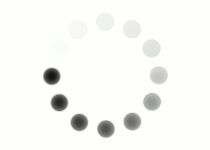At some point in this course, you will need to make a conjecture based on some examples and then prove your conjecture, using deduction. This video will demonstrate how to use these two processes in a geometry context. Before you start watching the video, you will need to gather some scrap paper and scissors. Be sure to keep a record of your work down in your notebook.
As you watch this video, use the study guide to follow along if you'd like. Click the button below to download the study guide.
![]() A conjecture is nothing more than a mathematical hypothesis based on observed behavior or patterns. Form a conjecture for example 1, and find the next two numbers of the sequence. Pause the video now, and resume playback in a moment to check your answers… You probably observed the numbers were increasing by three each time. If we continue that pattern, the next two numbers would be thirteen and sixteen. In another, more geometric example, we might need to answer the question, “what is the sum of the interior angle measures of a triangle?” We should look for patterns in several examples. I will show two examples on the screen, but you should try two examples on your own; an acute triangle for example. Or, since these two examples are scalene, you might try an equilateral or isosceles triangle.
A conjecture is nothing more than a mathematical hypothesis based on observed behavior or patterns. Form a conjecture for example 1, and find the next two numbers of the sequence. Pause the video now, and resume playback in a moment to check your answers… You probably observed the numbers were increasing by three each time. If we continue that pattern, the next two numbers would be thirteen and sixteen. In another, more geometric example, we might need to answer the question, “what is the sum of the interior angle measures of a triangle?” We should look for patterns in several examples. I will show two examples on the screen, but you should try two examples on your own; an acute triangle for example. Or, since these two examples are scalene, you might try an equilateral or isosceles triangle.
Start with a triangle of any shape or size, and then label each angle with the numbers one, two, and three. Tear apart the three angles, and then line up each of the angles. What kind of shape do these angles make? A straight line would be a good guess. Since we only rearranged the angles, and did not change their size, and since a straight line measures one hundred eighty degrees, what can we assume the interior angles of a triangle add to? One hundred eighty degrees is another good guess. Try writing the conjecture as an if/then statement. Pause the video, and resume it shortly to see what I came up with… My conjecture is this: If a shape is a triangle, then its interior angle measures sum to one hundred eighty degrees. Your conjecture might be a bit different, but it must be written in the if/then form, with a hypothesis (P) and a conclusion (Q). Remember, a conjecture is just a guess. We should prove conjectures with logic and reasoning, but we will not complete this proof now.
Instead, I would like to ask another question. What conjecture could you make about the sum of the interior angle measures of a quadrilateral? I’ll show you a hint… We can subdivide a quadrilateral into two triangles. And since we are pretty sure the sum of a triangle’s interior angles is one hundred eighty degrees, we can syllogistically form a conjecture. Do you remember from earlier in the chapter that a syllogism consists of a major premise and a minor premise used to form a conclusion? Here the major premise is that a quadrilateral can be subdivided into two triangles. And the minor premise is that the sum of the interior angles of each triangle is one hundred eighty degrees. Therefore, the conclusion in this case would be: the sum of the interior angles of a quadrilateral is three hundred sixty degrees.
In this video, we used a method called induction to form our conjecture. We observed patterns, and made a guess. Please be sure to review the methods we used so that you can use induction to form conjectures elsewhere in this course. Good luck!
Question
What should you do to make a conjecture based on the pattern: 17, 14, 11, 8...?
